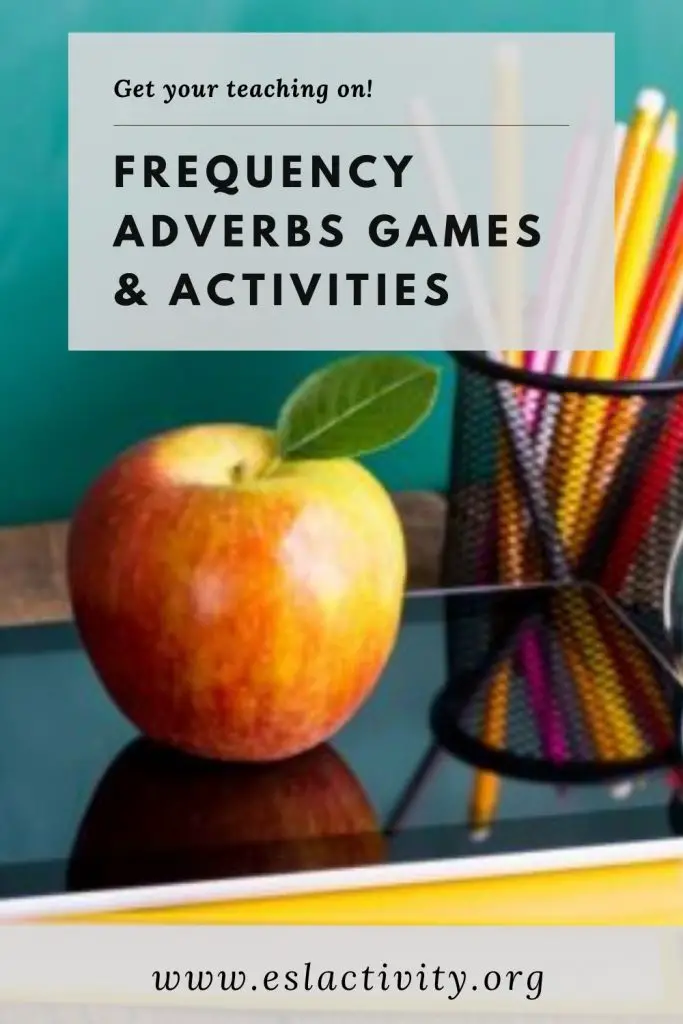If you’re looking for some games and activities to teach frequency adverbs, then you’re certainly in the right place. Keep on reading for all the details you need to know about adverbs of frequency games, along with lesson plans, worksheets, online practice opportunities and more.

Frequency adverbs activities
Frequency Adverbs Games and Activities ESL
Let’s get into the best adverbs of frequency ESL activities to try out with your students today.
#1: Frequency Adverb Survey
Just ask my students and they’ll tell you how much I love to use surveys in my classes! I do them around once a month in almost all my classes from beginners to more advanced students. They work particularly well with these kinds of adverbs as there are many questions related to lots of different topics.
Want to give surveys a try? Find out how to make your own as well as use them in class here:
#2: Concentration
Try out this fun memory game with your students! Make up a bunch of questions/answers related to frequency adverbs. There should be obvious correct matches. Some good ones include:
- How often do you go to the dentist? (Twice a year).
- How often do you eat something? (Four times a day).
Make cards with the questions/answers and then students can play this game in groups of four, trying to find the matches. Find out how to do it here:
#3: Daily Routines and Adverbs of Frequency
The perfect context for teaching this grammar point is daily routines. There are just so many questions possible related to things like eating, sleeping in, exercising, etc. Here are some of the best ideas for this:
#4: Frequency Adverbs Songs and Chants
When I teach kids, I love to include some songs and chants into my classes. It’s a fun way to help children remember new grammar or vocabulary. Sometimes, I even catch my students singing the songs outside of class and then I know that I’ve won the English teaching game!
I’m not musical, so I head over to YouTube. There are lots of good ones for just about anything, including adverbs of frequency.
#5: Dictogloss
Try out this challenging listening activity with more advanced-level students. Find (or write) a passage containing lots of the target vocabulary or grammar. Then, put students into pairs and read it out at a faster than normal pace for the level of the students.
The students can take notes as they listen and then attempt to recreate what they heard with their partner. Repeat the process again and finally, students compare their version with the original one. After that, it’s certainly possible to ask some comprehension questions related to just about anything. Try it out:
#6: Mixed up Sentence
I like to focus on forms and sentence building when teaching frequency adverbs because it can be a little bit tricky, particularly for beginners. Here’s a nice review activity that I like to use.
Write down a bunch of sentences that contain a mix of questions and statements using adverbs of frequency. Then, mix them up in terms of word order and students have to work together to unscramble then. I sometimes like to extend this activity by having students make a question if there’s a statement and vice-versa. Check it out:
Mixed Up Sentence ESL Grammar Activity.
#7: Ball Toss
This is a fun game for kids, teens or even adults. On a beach ball, write down a bunch of things that people do throughout their day. For example, eat breakfast, exercise, study English, meet up with friends, drink coffee, etc.
Then, students throw the ball around the class. The person catching it has to see where their right thumb if. If it’s “meet up with friends,” they have to ask a frequency question to the person who threw them the ball.
For example, “How often do you drink coffee?” Answer: “I drink coffee twice a day, in the morning and afternoon.”
Find out more about it here:
#8: Running Dictation
#9: Relay Race
I love to use this relay race because it turns something old (error correction) into something new again. Write (or find) a passage where someone is talking about something like their healthy/unhealthy habits but make some mistakes. I like to make some errors with both forms (I play soccer one time a week) and meaning (I go to the dentist every week).
Then, it becomes a relay race where students have to make the corrections. Find out more:
#10: Dictation
I know that dictation is a little bit old school, but it’s still a nice activity to do once in a while. In this case, I like to dictate a mix of questions/answers to my students who have to write them down in the notebooks.
Then, once that’s done, I get students to answer the question or make a question for the statement. Simple but effective and it’s the perfect activity for the introverts in your class! Plus, it’s a nice way to focus on forms. Find out more:
#11: Typhoon Game
A nice way to review just about anything, including adverbs of frequency is with this typhoon game:
#12: Man/Woman on the Street
These kinds of adverbs lend themselves particularly well to interview-style activities. For example, students can interview each other to find out if their partner has mostly healthy or unhealthy habits.
If you want to make this style of activity a bit more interesting, consider this man or woman on the street interview. It’s fun, engaging and the students get a kick out of it. Try it out:
Man/Woman on the Street Interview Activity.
#13: Reading Lesson Plans for Frequency Adverbs
I like to include some reading-focused lessons in my general English classes. It’s a nice change of pace from the usual communicative style activities. It’s also the perfect way to get students to “notice” language such as these kinds of adverbs.
If you’re a bit nervous about making this style of lesson, not to worry! Here’s a simple template to follow:
ESL Reading Lesson Plan Template.
#14: Dialogue Substitution
#15: Closest in Meaning
If you REALLY want to make sure that your students understand the meaning of frequency adverbs, then closest in meaning is the perfect activity for that. Give students a target sentence and then 2-3 other ones. One of these should be the same while the others are only similar. An example.
Target sentence: I usually play soccer once or twice a week.
Other sentences:
- I like to play soccer 5-6 times a month.
- I’m playing soccer a few times a year.
- I enjoy playing soccer almost every day.
The first one is the correct answer, but it can be a little bit tricky depending on the target sentence and additional sentences. Check it out here:
Closest in Meaning ESL Activity.
#16: Is that Sentence Correct?
A nice way to review forms is to use this simple error correction activity. Write a bunch of sentences with the target grammar or vocabulary in them. Some should be correct while others are not. Students have to choose the incorrect sentences and change them to make them correct. Learn more about it:
ESL Sentence Correction Activity.
#17: ESL Board Games
#18: Me Too!
This is a simple listening and speaking activity that’s ideal for smaller classes. Each person has to make a statement using a frequency adverb (I drink coffee every day). If other people are the same, they have to stand up and say, “Me too!” Check it out:
Me Too! Listening and Speaking TEFL Activity.
#19: Find Someone Who Bingo Game
This is a Bingo game with a twist! Students have to circulate around the class finding their matches. For frequency adverbs, I get students to fill up the board with their own questions. For example:
- Coffee-every morning
- Exercise-a few times a week
- Junk food-never
- Etc.
Then, students have to make good questions to ask their classmates to try to find a match. Learn how to do it:
#20: Listening for One Specific Thing
A nice idea for an adverb of frequency lesson plan is to include a listening exercise where students have to listen for this specific thing. There are lots of sources for listening passages, including:
- ESL textbooks
- Movies/TV
- Interview on YouTube
- Etc.

Adverbs of Frequency games
#21: The Flyswatter Adverbs of Frequency ESL Game
Try out this fun game if you want to have some fun times in your English class! Write down a bunch of adverbs of frequency in a random fashion on the whiteboard.
Then, one student from each team comes up the front and grabs a flyswatter. Say an activity (go to English class) and students race to hit one of the words that could fit (usually, always, etc.). Then, I have students repeat the sentence with their chosen word (I always go to English class).
The first student to do this correctly gets a point. Continue until everyone has had a chance to play. Check it out:
#22: Information Gap Activities
#23: 3 in a Row
Try out this simple game that’s similar to X + O. Fill up a grid with various adverbs of frequency. Then, they have to choose one of the words and make a true sentence. If they can do it, they mark the square with their symbol. Then the next student goes and uses a different symbol. The student with the most 3 in a rows in the allotted amount of time is the winner.
#24: Adverb Sort
Prepare a list of sentences or phrases that contain different adverbs of frequency mixed together. Students work in pairs or small groups to categorize the adverbs into groups such as “always,” “often,” “sometimes,” “rarely,” and “never.” They can discuss their choices and reasons for categorization.
#25: Vocabulary Auction
#26: Adverb Gallery Walk
Display pictures or images representing various activities. Students walk around the classroom and write sentences describing how often they do each activity using adverbs of frequency. They can also compare their sentences with a partner or discuss their routines with classmates.
#27: Adverb Role-Play
Assign students different roles, such as a teacher, a student, a parent, or a doctor. They engage in role-play conversations using adverbs of frequency to talk about typical routines, habits, or advice related to their assigned role.
#28: Adverb Quiz Show
Divide the class into teams and host a quiz show-style activity. Ask questions about frequency using adverbs, and teams compete to provide the correct answer. This activity can be done with buzzers or whiteboards for team responses.
Frequency Adverbs Worksheets
If you want to give your students some additional practise with adverbs or frequency, then check out the following worksheets:
Adverbs of Frequency ESL Lesson Plans
If you’re a teacher, then you’ll know what a time-saver it can be to just print off a lesson plan and take it to class. Here are some of the best frequency adverb lesson plans:
Online Practice for Frequency Adverbs
If your students want some additional practice, here are a few of the resources that I recommend to mine:
Adverbs of Frequency FAQs
There are a number of common questions that people have about frequency adverbs. Here are the answers to some of the most popular ones.
What is a frequency adverb?
A frequency adverb describes how often something happens. In English, the main adverbs of frequency are: always, usually/normally, often, sometimes, rarely, and never.
What are some examples of adverbs of frequency?
Adverbs of frequency describe how often something happens. Some examples are:
- I always do my homework at night.
- He sometimes eats pasta for dinner.
- I never play tennis.
How do you teach adverbs of frequency?
The best way to teach adverbs of frequency is to introduce them in context through a listening or reading passage. Then, focus on forms through controlled practice and finally, offer some freer practice opportunities with some games or activities. Round it off with a frequency adverb homework assignment.
Is always an adverb?
Yes, always is an adverb. It’s a frequency adverb that describes how often an action happens.
How do you ask frequency adverbs?
To ask a question using frequency adverbs, start it off with, “How often…” For example,
- How often do you play soccer?
- How often do you go to the dentist?
Did you like these Adverbs of Frequency Games and Activities?
- Amazon Kindle Edition
- Bolen, Jackie (Author)
- English (Publication Language)
- 112 Pages - 10/24/2019 (Publication Date)
If you like these ESL games and activities, then you’re going to love this book over on Amazon: 39 No-Prep/Low-Prep ESL Grammar Activities and Games. The key to great English classes is a wide variety of interesting and engaging activities and this book will help you do that in style!
You can find the book in both digital and print formats. Pick up a copy to keep on the bookshelf in your office to use as a handy reference guide. Or, consider taking the e-version with you to your favourite coffee shop on any device for some serious lesson planning on the go.
Whatever the situation, get ready for some ESL teaching awesome in your life. Click the button below to head over to Amazon to find out all the details you need to know and to pick up your copy today.
Tips for Teaching Adverbs of Frequency
Teaching adverbs of frequency in ESL can be made more effective with the following tips.
Start with Basic Vocabulary
Begin by introducing basic vocabulary related to adverbs of frequency, such as “always,” “usually,” “sometimes,” “rarely,” and “never.” Ensure students understand the meaning of these adverbs and can distinguish them from other types of adverbs.
Contextualize with Daily Routines
Relate adverbs of frequency to students’ daily routines and activities. Provide examples of how often they perform certain actions, such as “I always brush my teeth in the morning” or “I rarely eat fast food.”
Use Visuals and Examples
Utilize visual aids, such as charts, diagrams, or flashcards, to illustrate the meaning and usage of adverbs of frequency. Provide written and spoken examples to reinforce understanding and promote retention.
Sentence Formation and Frequency Adverbs
Guide students in forming sentences using adverbs of frequency. Start with simple subject-verb-adverb structures, such as “He always plays soccer” or “She never arrives late.” Gradually introduce more complex sentence structures as students become more comfortable.
Role-playing and Discussions
Engage students in role-playing activities or discussions that involve adverbs of frequency. Encourage them to ask and answer questions about their own habits or those of others, using the appropriate adverbs. For example, “How often do you exercise?” or “Does she usually watch TV in the evenings?”
Time Expressions with Adverbs of Frequency
Introduce time expressions that are commonly used with adverbs of frequency, such as “every day,” “once a week,” “twice a month,” or “on weekends.” Teach students how to combine these expressions with adverbs of frequency to provide more specific information.
Adverb Placement
Explain the placement of adverbs of frequency within a sentence. Typically, they are placed before the main verb but after the auxiliary verb or “be” verb. Reinforce this through practice exercises and sentence construction activities.
Adverbial Phrases
Teach students that adverbs of frequency can also be expressed through adverbial phrases. For example, “three times a week” or “once in a while” indicate specific frequencies. Practice using these phrases in various contexts.
Contrast with Other Adverbs
Highlight the differences between adverbs of frequency and other types of adverbs. Help students understand that while adverbs of frequency describe how often an action occurs, other adverbs describe different aspects such as manner, time, place, or degree.
Regular Practice with Adverbs of Frequency
Provide regular opportunities for students to practice using adverbs of frequency in both written and spoken activities. Include exercises, games, or worksheets that require them to apply their knowledge in different contexts.
Frequency Adverb Activities and Games: Join the Conversation
What’s your top pick for a fun TEFL game or activity to help students practice frequency adverbs? Is it one of the options from this list or do you have your eye on another one? Leave a comment below and let us know what you think. We’d love to hear from you.
Also, be sure to give this article a share on Facebook, Pinterest, or Twitter. It’ll help other busy English teachers, like yourself, find this useful teaching resource.

Frequency adverbs worksheets, questions, activities
Last update on 2022-07-17 / Affiliate links / Images from Amazon Product Advertising API





